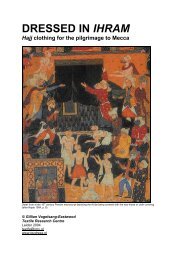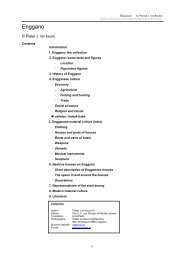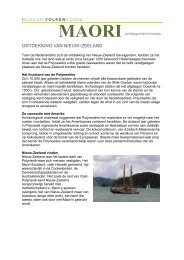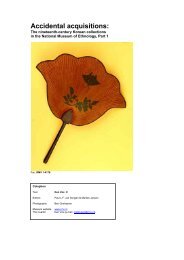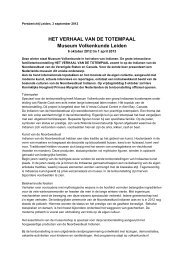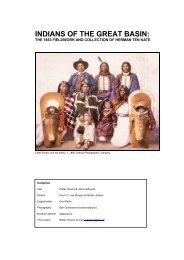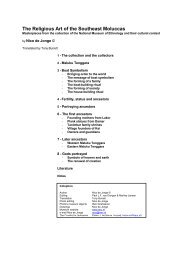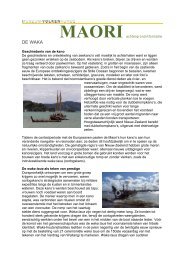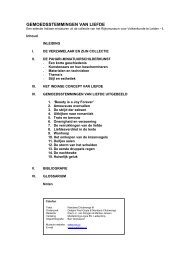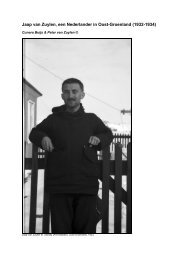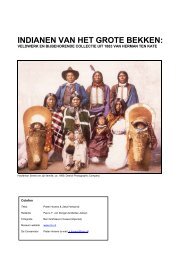Political Clothing in Afghanistan - Museum Volkenkunde
Political Clothing in Afghanistan - Museum Volkenkunde
Political Clothing in Afghanistan - Museum Volkenkunde
You also want an ePaper? Increase the reach of your titles
YUMPU automatically turns print PDFs into web optimized ePapers that Google loves.
<strong>Political</strong> <strong>Cloth<strong>in</strong>g</strong> <strong>in</strong> <strong>Afghanistan</strong><br />
Willem Vogelsang ©<br />
National <strong>Museum</strong> of Ethnology, Leiden<br />
A chapan. RMV 5975-12<br />
Colophon<br />
Text: Willem Vogelsang ©<br />
Editors:<br />
Photography:<br />
Paul L.F. van Dongen & Marlies Jansen<br />
Ben Grishaaver (museum objects)<br />
Other photographs: By the author, from various publications and from the ‘www’<br />
<strong>Museum</strong> website:<br />
The Curator:<br />
www.rmv.nl<br />
Willem Vogelsang (e-mail: mailto:willemv@rmv.nl)
POLITICAL CLOTHING IN AFGHANISTAN. © WILLEM VOGELSANG<br />
Digital publications from the National <strong>Museum</strong> of Ethnology<br />
Table of contents<br />
Introduction<br />
I. The f<strong>in</strong>e coat makes the f<strong>in</strong>e gentleman<br />
II.<br />
III.<br />
IV.<br />
The Afghan patchwork<br />
A royal gift<br />
Macnaghten’s coat<br />
V. Paukul aga<strong>in</strong>st turban<br />
VI.<br />
VII.<br />
VIII.<br />
The Karzai-look<br />
The Chapan: show your hands<br />
Bibliography<br />
1
POLITICAL CLOTHING IN AFGHANISTAN. © WILLEM VOGELSANG<br />
Digital publications from the National <strong>Museum</strong> of Ethnology<br />
Introduction<br />
Welke kled<strong>in</strong>g draagt een politiek leider om <strong>in</strong>druk te maken op zijn aanhangers of zijn tegenstanders?<br />
Of wat draagt hij – of zij – om juist boven de partijen te staan en voor iedereen een geaccepteerd<br />
gezagsdrager te zijn?<br />
In <strong>Afghanistan</strong> zijn deze vragen door de recente ontwikkel<strong>in</strong>gen heel actueel. Eeuwenoude tradities<br />
blijken grote <strong>in</strong>vloed te hebben op de kled<strong>in</strong>gkeuzes van zowel de oude als de nieuwe machthebbers.<br />
Over wat zij droegen en dragen kunt u meer lezen <strong>in</strong> deze digitale publicatie, met voorbeelden uit de<br />
eigen collectie van het Rijksmuseum voor <strong>Volkenkunde</strong>.<br />
2
I. The f<strong>in</strong>e coat makes the f<strong>in</strong>e gentleman<br />
POLITICAL CLOTHING IN AFGHANISTAN. © WILLEM VOGELSANG<br />
Digital publications from the National <strong>Museum</strong> of Ethnology<br />
We all know the image of Nelson Mandela. Even if we do not recall his face, we certa<strong>in</strong>ly<br />
know the colourful shirt he is always wear<strong>in</strong>g. That garment has become the trademark of the<br />
South African leader. Is it pure co<strong>in</strong>cidence that each morn<strong>in</strong>g he dons such a colourful shirt?<br />
That seems unlikely. Mandela knows very well what he is do<strong>in</strong>g. Is it then his particular taste,<br />
or his lik<strong>in</strong>g for particular colour comb<strong>in</strong>ations, that makes him so easily recognisable each<br />
day? Perhaps, but <strong>in</strong> that case his sartorial taste is rather limited, and I do not th<strong>in</strong>k we should<br />
underestimate Mandela <strong>in</strong> this respect. There is far more on hand.<br />
Nelson Mandela with young fans.<br />
Mandela uses his shirt to show the world how he wants to be seen, namely as an African<br />
leader who does not belong to the Western-oriented clique of tie-wear<strong>in</strong>g politicians from all<br />
over the world. He is different. Mandela wants to come across as someone he wants to be<br />
himself, someone who is ''normal'', close to the people. Someone who is always optimistic,<br />
happy and positive-m<strong>in</strong>ded. That image, of course, tallies very well with what Mandela is<br />
th<strong>in</strong>k<strong>in</strong>g and do<strong>in</strong>g. But would you buy a second-hand bicycle from someone wear<strong>in</strong>g such a<br />
shirt? Or would you expect your <strong>in</strong>surance agent to appear with such a garment? Or the<br />
chairman of the Board of Directors of a mult<strong>in</strong>ational?<br />
<strong>Cloth<strong>in</strong>g</strong> is a form of communication, but without words. With our cloth<strong>in</strong>g we <strong>in</strong>dicate who we<br />
are, and especially how we want others to see us. From the other side we also judge people<br />
on the basis of what they are wear<strong>in</strong>g. A nice, three-piece suit of pure wool <strong>in</strong>spires<br />
confidence <strong>in</strong> the wearer, but do we have any trust <strong>in</strong> someone wear<strong>in</strong>g a sh<strong>in</strong><strong>in</strong>g nylon outfit?<br />
Politicians can use their cloth<strong>in</strong>g to dist<strong>in</strong>guish themselves. With their cloth<strong>in</strong>g they can<br />
<strong>in</strong>dicate what policy they stand for, and what k<strong>in</strong>d of person they are, or want to be <strong>in</strong> the eyes<br />
of their potential followers. Have you ever looked closely at the cloth<strong>in</strong>g of Saddam Husayn of<br />
Iraq? When he was by himself, he often wore a military uniform, but when he was shown<br />
surrounded by his generals, he was usually the only one <strong>in</strong> the group who was not wear<strong>in</strong>g a<br />
uniform.<br />
Sadam Husayn chair<strong>in</strong>g his cab<strong>in</strong>et.<br />
3
POLITICAL CLOTHING IN AFGHANISTAN. © WILLEM VOGELSANG<br />
Digital publications from the National <strong>Museum</strong> of Ethnology<br />
Saddam Husayn wanted to show his military strength and manl<strong>in</strong>ess. But surrounded by his<br />
generals, who looked at him as though he was God himself, he showed, by not wear<strong>in</strong>g a<br />
uniform, that he was even more important than the generals.<br />
Bush and Blair<br />
When George Bush is on the campaign trail, he often wears a red-coloured tie. Tony Blair <strong>in</strong><br />
Brita<strong>in</strong> does the same th<strong>in</strong>g. Why? Because red is an aggressive colour, that shows selfconfidence<br />
and assertiveness. The Dutch politician Pim Fortuyn, who attracted a wide<br />
follow<strong>in</strong>g <strong>in</strong> 2001-2002 and who was later assass<strong>in</strong>ated, liked to wear a three-piece grey suit<br />
with an enormous knot <strong>in</strong> his tie. He also liked to be photographed with a huge cigar <strong>in</strong> his<br />
hand. In his presentation he rem<strong>in</strong>ded people of W<strong>in</strong>ston Churchill. Was this pure<br />
co<strong>in</strong>cidence? Did Pim Fortuyn want to imitate the wartime British leader?<br />
Fortuyn and Churchill<br />
The reader will also remember the lo<strong>in</strong>cloth of Mahatma Gandhi. A beautiful symbol for the<br />
non-violent Indian opposition aga<strong>in</strong>st British colonialism. And does the reader know that<br />
Yasser Arafat, the Palest<strong>in</strong>ian leader, regards his headcloth of such importance that it is<br />
deliberately sewn onto his green army-style jacket <strong>in</strong> the shape of Palest<strong>in</strong>e?<br />
Yasser Arafat<br />
4
POLITICAL CLOTHING IN AFGHANISTAN. © WILLEM VOGELSANG<br />
Digital publications from the National <strong>Museum</strong> of Ethnology<br />
II. The Afghan patchwork<br />
F<strong>in</strong>e cloth<strong>in</strong>g makes a f<strong>in</strong>e gentleman, also <strong>in</strong> <strong>Afghanistan</strong>. Specific cloth<strong>in</strong>g also makes the<br />
identity of an Afghan politician. <strong>Cloth<strong>in</strong>g</strong> has always played an important role <strong>in</strong> <strong>Afghanistan</strong>.<br />
There are more than fifty different ethnic groups <strong>in</strong> the country, each with their own identity,<br />
often with their own language, and <strong>in</strong> many cases also with their own cloth<strong>in</strong>g traditions.<br />
There are also various religious groups and specific regional characteristics. <strong>Afghanistan</strong> is a<br />
patchwork of ethnic groups that are led by a rudimentary central government. With his<br />
cloth<strong>in</strong>g the Afghan politician may show to which ethnic group he belongs, and with which<br />
religious community he wants to associate himself. In this way he can more easily attract his<br />
potential followers. With his cloth<strong>in</strong>g he may also show whether he wants to develop the<br />
central government, but <strong>in</strong> that case he is not likely to wear regional cloth<strong>in</strong>g, but garments<br />
that are accepted all over the country, or even regarded as be<strong>in</strong>g <strong>in</strong>ternational.<br />
With his cloth<strong>in</strong>g the Afghan politician may show even more: he can <strong>in</strong>dicate whether he is<br />
rich or poor, or whether he is <strong>in</strong> favour with the highest authorities, or whether he has good<br />
contacts with <strong>in</strong>ternational powers, or <strong>in</strong>deed whether he has travelled abroad.<br />
For Afghan leaders cloth<strong>in</strong>g was and is a direct way to show their importance, their policies,<br />
and whether they regard themselves primarily as Afghan citizens or as representatives of a<br />
specific ethnic or religious group. The Afghan k<strong>in</strong>g Amanullah (1919-1929), who advocated a<br />
policy of drastic reforms, liked to have himself portrayed <strong>in</strong> a Western-style uniform, <strong>in</strong> order<br />
thus to show that he wanted to break with the traditional past.<br />
K<strong>in</strong>g Amanullah (1919-1929)<br />
5
POLITICAL CLOTHING IN AFGHANISTAN. © WILLEM VOGELSANG<br />
Digital publications from the National <strong>Museum</strong> of Ethnology<br />
III. A royal gift<br />
In the past, cloth<strong>in</strong>g <strong>in</strong> <strong>Afghanistan</strong> and beyond was not only a means to show the wearer’s<br />
identity. <strong>Cloth<strong>in</strong>g</strong> was also used as a gift <strong>in</strong> order to illustrate the special relationship between<br />
giver and receiver. In ancient Persia, some 2,500 years ago, subjects used to present their<br />
k<strong>in</strong>g with complete costumes: coats, trousers, boots, weapons, headgear, etc., and from<br />
stories we know that <strong>in</strong> his turn the k<strong>in</strong>g rewarded his loyal subjects with (even more) costly<br />
garments.<br />
From the more recent history of the Middle East we know the concept of the Khilat. That was<br />
a suit, or more specifically a coat that was given by the ruler to his subjects, to be worn as a<br />
symbol of their specific relationship as towards the ruler. To the receiver the coat was a way<br />
to show who he was: a favourite of the ruler, someone who could take an important place<br />
with<strong>in</strong> his own community because he had access to the ruler. On the other hand, such a gift<br />
and the status that went with it also made the receiver some sort of middleman <strong>in</strong> the<br />
relationship between the ruler and his subjects. In other words, the wearer of the coat was<br />
bought by the k<strong>in</strong>g to become his representative.<br />
At the end of the n<strong>in</strong>eteenth century there were many tailors <strong>in</strong> Kabul who were constantly at<br />
work sew<strong>in</strong>g khilats, which the Amir of the land, Abdur Rakhman Khan, gave to his important<br />
subjects. The Amir also presented these garments to prom<strong>in</strong>ent religious leaders, s<strong>in</strong>ce the<br />
latter wielded a great degree of power among the local population and <strong>in</strong> do<strong>in</strong>g so the Amir<br />
wanted to make sure that they would cont<strong>in</strong>ue to support him. It was the ancient way of<br />
buy<strong>in</strong>g the religious leaders.<br />
Portrait of Amir Abdur Rakhman Khan (r. 1880-1901) (Source: Spykes 1981)<br />
6
POLITICAL CLOTHING IN AFGHANISTAN. © WILLEM VOGELSANG<br />
Digital publications from the National <strong>Museum</strong> of Ethnology<br />
IV. Macnaghten’s coat<br />
<strong>Cloth<strong>in</strong>g</strong> as a status symbol and as a means to symbolise the relationship between politicians<br />
and followers is beautifully illustrated by a coat that for more than a century has been housed<br />
<strong>in</strong> the National <strong>Museum</strong> of Ethnology, Leiden. Accord<strong>in</strong>g to the museum archives this<br />
garment was granted around AD 1840 by the Afghan k<strong>in</strong>g of that time, Shah Shuja, to the<br />
British official, William Hay Macnaghten.<br />
Macnaghten’s coat, RMV 3934-1.<br />
The gift of this coat was highy symbolic and confirmed the close relationship between the<br />
Afghan k<strong>in</strong>g and the British colonial officer, who had been appo<strong>in</strong>ted as “Envoy and M<strong>in</strong>ister<br />
for the Government of India to the Court of Shah Shuja al-Mulk”. Macnaghten, however, was<br />
far more than an ambassador at the court of an oriental monarch. He represented British<br />
authority that <strong>in</strong> AD 1839, dur<strong>in</strong>g the First Anglo-Afghan War and with a large army, had put<br />
the same Shah Shuja on the Kabul throne. In fact it was Macnaghten who ruled the country,<br />
rather than Shah Shuja. Yet the British tried all they could to conv<strong>in</strong>ce the Afghans that they<br />
were there merely to support the new k<strong>in</strong>g, rather than profil<strong>in</strong>g themselves as the de facto<br />
rulers. That would have only antagonised the Afghan people. The gift of the coat, therefore,<br />
symbolised the authority of Shah Shuja, which the British were very happy to accept, but<br />
which <strong>in</strong> reality hardly existed. 1<br />
Sir William Hay Macnaghten (1793-1841) left, and Shah Shudja al-Mulk' (1780-1842) right. (source: Caroe 1958)<br />
7
POLITICAL CLOTHING IN AFGHANISTAN. © WILLEM VOGELSANG<br />
Digital publications from the National <strong>Museum</strong> of Ethnology<br />
V. Paukul aga<strong>in</strong>st turban<br />
Between 1978 and 1992, <strong>Afghanistan</strong> was ruled by a Marxist regime that could only rema<strong>in</strong> <strong>in</strong><br />
power with the massive assistance from the side of the former Soviet Union. Dur<strong>in</strong>g the time,<br />
the local resistance, the Mujahid<strong>in</strong>, started to wear a paukul, a cap with a rolled-up edge.<br />
A paukul (RMV 5975-2)<br />
All over the country this garment soon became the symbol of the mostly young resistance<br />
fighters of various orig<strong>in</strong>s who took up arms ga<strong>in</strong>st the Red Army.<br />
Mudjahed<strong>in</strong> with paukul (1982)<br />
The paukul is orig<strong>in</strong>ally a garment that was worn <strong>in</strong> the northeast of <strong>Afghanistan</strong> and the north<br />
of Pakistan. The exact history of this type of headgear rema<strong>in</strong>s unclear, but it is possible that<br />
it was already be<strong>in</strong>g worn by the time of Alexander the Great, who campaigned <strong>in</strong> this<br />
<strong>in</strong>hospitable part of the world around <strong>in</strong> c. 330 BC. In any case, between 1980 and 1990 it<br />
was be<strong>in</strong>g worn by resistance fighters as a symbol of their political and military position. It was<br />
also worn by the Pashtun from the south and east of the country, who are traditionally more<br />
<strong>in</strong>cl<strong>in</strong>ed to wear a turban (lungi) on their heads.<br />
Pashtun-mudjahed<strong>in</strong> with turban (1982).<br />
8
POLITICAL CLOTHING IN AFGHANISTAN. © WILLEM VOGELSANG<br />
Digital publications from the National <strong>Museum</strong> of Ethnology<br />
In the 1990’s the situation changed when the Taliban took over control <strong>in</strong> <strong>Afghanistan</strong>. The<br />
Taliban (‘religious students’) were predom<strong>in</strong>antly of Pashtun orig<strong>in</strong> from the south of the<br />
country, especially from the area around the city of Kandahar. They fought aga<strong>in</strong>st the<br />
<strong>in</strong>fluence of the Tajiks from the northeast of the country, who <strong>in</strong> 1992 had taken over control<br />
of the capital Kabul after the fall of the Marxist regime. This was one of the reasons why the<br />
Taliban deliberately opted to wear turbans, rather than the paukul. Eventually, the paukul was<br />
forbidden, and the turban was made obligatory. Between 1996, when the city was taken by<br />
the Taliban, and the w<strong>in</strong>ter of 2001/2 when the Taliban were driven out aga<strong>in</strong>, the paukul was<br />
not seen <strong>in</strong> Kabul. However, after the retreat of the religious students the men of Kabul not<br />
only shaved their beards, but many also threw off their turbans and donned a paukul. For a<br />
while, turban dealers <strong>in</strong> Kabul had noth<strong>in</strong>g to do, while paukul traders could hardly keep up<br />
with the demand for the paukul caps.<br />
The paukul has now, by 2002, become the headgear of the rulers of post-Taliban<br />
<strong>Afghanistan</strong>. But many Afghans feel uneasy about the <strong>in</strong>fluence of the Tajiks <strong>in</strong> the present<br />
government of the country. In particular, the Pashtun tend to feel cheated and humiliated. In<br />
Kandahar, and <strong>in</strong> the rest of southern <strong>Afghanistan</strong> where most of the Pashtun live, very few<br />
men wear a paukul, and the turban is still dom<strong>in</strong>ant.<br />
Street scene from Kandahar (2002)<br />
9
POLITICAL CLOTHING IN AFGHANISTAN. © WILLEM VOGELSANG<br />
Digital publications from the National <strong>Museum</strong> of Ethnology<br />
VI. The Karzai-look<br />
At present, <strong>in</strong> December 2002, the paukul and lungi symbolise <strong>in</strong> <strong>Afghanistan</strong> the political<br />
situation. In general terms, the paukul goes with the w<strong>in</strong>ners, and the lungi with the defeated<br />
party. In Kabul the paukul dom<strong>in</strong>ates the streets, <strong>in</strong> Kandahar the lungi. In Kabul the Tajiks<br />
dom<strong>in</strong>ate, <strong>in</strong> Kandahar the Pashtun. But what to wear when you are a Pashtun and when you<br />
are elected as president of post-Taliban <strong>Afghanistan</strong>? That was the dilemma that confronted<br />
Hamid Karzai when early <strong>in</strong> December 2001 he was <strong>in</strong>formed over the telephone that the<br />
Afghans and foreign diplomats meet<strong>in</strong>g at that time <strong>in</strong> Germany had elected him as the leader<br />
of the <strong>in</strong>terim government of the country. At that time Hamid Karzai was with his own tribal<br />
follow<strong>in</strong>g, somewhere to the north of Kandahar, where he was try<strong>in</strong>g to persuade his followers<br />
to take the last Taliban centre <strong>in</strong> <strong>Afghanistan</strong>, the city of Kandahar.<br />
Hamid Karzai, who for many years had lived outside of <strong>Afghanistan</strong> and was used to wear<strong>in</strong>g<br />
Western cloth<strong>in</strong>g, was photographed <strong>in</strong> November 2001, somewhere north of Kandahar, <strong>in</strong><br />
typical Pashtun dress: a shalwar kamiz (baggy trousers and loose shirt), a waistcoat (waskat),<br />
and a turban (lungi). With this outfit he wanted to show ‘his’ Pashtun that he was one of them.<br />
Hamid Karzai wear<strong>in</strong>g characteristic Pashtun dress.<br />
Almost a day after his election as leader of the Afghan <strong>in</strong>terim government, Hamid Karzai had<br />
completely changed his outfit. He no longer was photographed wear<strong>in</strong>g the Pashtun dress,<br />
but he appeared <strong>in</strong> public wear<strong>in</strong>g garments that attracted <strong>in</strong>ternational attention, also from<br />
famous Western couturiers. The Karzai look was born.<br />
Hamid Karzai <strong>in</strong> his characteristic cloth<strong>in</strong>g.<br />
10
POLITICAL CLOTHING IN AFGHANISTAN. © WILLEM VOGELSANG<br />
Digital publications from the National <strong>Museum</strong> of Ethnology<br />
What is Hamid Karzai mostly wear<strong>in</strong>g <strong>in</strong> public? In the first place, he neither wears a turban<br />
nor a paukul. The turban would have made him unacceptable to the Tajiks. It would have<br />
l<strong>in</strong>ked him to the Pashtun and the hated Taliban. But Karzai could not don a paukul either, for<br />
that would have antagonised the Pashtun who had dom<strong>in</strong>ated Afghan politics for such a long<br />
time. Karzai therefore opted for the so-called qarakuli, or J<strong>in</strong>nah cap, as it is also called, after<br />
Mohammed Ali J<strong>in</strong>nah (AD 1876-1948), the found<strong>in</strong>g father of modern Pakistan.<br />
A qarakuli (RMV 5975-4) and a portrait of Mohammed Ali J<strong>in</strong>nah<br />
The qarakuli is traditionally made of the fleece of Persian lamb (astrakhan), especially from<br />
among the Turkmen from northwestern <strong>Afghanistan</strong> and from the modern republic of<br />
Turkmenistan. The highest quality is golden brown <strong>in</strong> colour, and that is the type of qarakuli<br />
that Karzai prefers to wear.<br />
The qarakuli’s are worn <strong>in</strong> <strong>Afghanistan</strong> and beyond by the well-to-do people, who use this<br />
form of headgear to demonstrate their wealth and important position. The qarakuli is not<br />
bound to a specific ethnic or religious group <strong>in</strong> the country, and therefore em<strong>in</strong>ently suitable<br />
for Karzai to wear. In this way he puts himself above the various ethnic groups of the country.<br />
11
POLITICAL CLOTHING IN AFGHANISTAN. © WILLEM VOGELSANG<br />
Digital publications from the National <strong>Museum</strong> of Ethnology<br />
VII: The Chapan: Show your hands<br />
However, there is another garment that is worn by Hamid Karzai s<strong>in</strong>ce December 2001. That<br />
is the so-called chapan, a calf-length coat with long sleeves that is usually worn loosely over<br />
the shoulders.<br />
Karzai (centre) and others with the characteristic chapan, and a chapan from the museum collection (RMV 5975-12)<br />
This type of coat has a very long history <strong>in</strong> <strong>Afghanistan</strong> and the Middle East. The important<br />
aspect for Karzai was the fact that, although predom<strong>in</strong>antly worn <strong>in</strong> northern <strong>Afghanistan</strong>, it is<br />
also known among the Pashtun and is worn by the rich and wealthy. There are beautiful pr<strong>in</strong>ts<br />
from the early n<strong>in</strong>eteenth century where Pashtun are depicted wear<strong>in</strong>g chapan-style<br />
garments.<br />
Pr<strong>in</strong>ts of Pashtun leaders with chapan-style coat (c. AD 1810). (Source: Elph<strong>in</strong>stone 1998)<br />
At the beg<strong>in</strong>n<strong>in</strong>g of this account I referred to the idea of khilat and I also referred to ancient<br />
Persia. The subjects of the Persian k<strong>in</strong>g who presented garments to the k<strong>in</strong>g also sometimes<br />
gave a type of coat that very much resembles the chapan as worn by Hamid Karzai. The<br />
Persian garment was also worn loosely over the shoulders; and the sleeves were left hang<strong>in</strong>g<br />
empty. The delegations who presented these garments all derived from the northern parts of<br />
the Persian empire, close to Central Asia. Here, <strong>in</strong> what is now often called Siberia, the orig<strong>in</strong><br />
of this coat should be sought.<br />
12
POLITICAL CLOTHING IN AFGHANISTAN. © WILLEM VOGELSANG<br />
Digital publications from the National <strong>Museum</strong> of Ethnology<br />
Persepolis, Apadana; Persian (left) and Median (right) dignitaries, turn of the 6th-5th c. BC.<br />
(Source: Gervers-Molnár 1973)<br />
From the middle of the second millennium BC there are many depictions of this type of coat.<br />
The ancient Greeks, <strong>in</strong> their stories about Iran and Central Asia, called it the kandys. They tell<br />
that it was normally worn with empty sleeves, but <strong>in</strong> the presence of the k<strong>in</strong>g the subjects had<br />
to put their arms <strong>in</strong>to the sleeves, as a sign of respect, and obviously also to make sure they<br />
could not use their weapons.<br />
The famous Oxus Treasure, that at the end of the n<strong>in</strong>eteenth century was found along the<br />
northern borders of <strong>Afghanistan</strong> and most of which has ended up <strong>in</strong> the British <strong>Museum</strong> <strong>in</strong><br />
London, <strong>in</strong>cludes some beautiful depictions of men wear<strong>in</strong>g the kandys. One of these is a<br />
man stand<strong>in</strong>g <strong>in</strong> a chariot. All these objects date back to the second half of the first millennium<br />
The kandys, or a coat of the same type, was also worn <strong>in</strong> Ch<strong>in</strong>a from the second half of the<br />
first millennium BC. It was regarded as the typical garment of the people from the steppes<br />
and deserts along Ch<strong>in</strong>a’s northern and western borders. All of this illustrates the orig<strong>in</strong> of the<br />
kandys: the steppes of South Central Asia, from where <strong>in</strong> the early first millennium BC the<br />
horse-rid<strong>in</strong>g Scythians (or Sakas) brought it to Iran and <strong>Afghanistan</strong>. They <strong>in</strong>troduced various<br />
<strong>in</strong>novations, <strong>in</strong>clud<strong>in</strong>g rid<strong>in</strong>g a horse, wear<strong>in</strong>g trousers, the use of the composite bow, and the<br />
kandys / chapan.<br />
Depictions of a Scythians with a kandys. (Source: Gervers-Molnár 1973)<br />
13
POLITICAL CLOTHING IN AFGHANISTAN. © WILLEM VOGELSANG<br />
Digital publications from the National <strong>Museum</strong> of Ethnology<br />
The Central Asian orig<strong>in</strong> of the coat with empty sleeves is also <strong>in</strong>dicated by the Hungarians.<br />
This ethnic group migrated <strong>in</strong> the early Middle Ages from Central Asia to the valley of the<br />
Danube <strong>in</strong> eastern Europe, where they still live. They <strong>in</strong>troduced various Central Asian<br />
traditions, <strong>in</strong>clud<strong>in</strong>g a coat with very long sleeves. The garment was later known among the<br />
Hungarians as the szür, but also as the szür-köntös. The latter name is also fund among the<br />
Ottoman Turks, who used the word kontos for a garment worn by Tartar leaders from north of<br />
the Black Sea. The Polish used the word kuntusz or kontusz for a similar long coat with empty<br />
sleeves. An <strong>in</strong>terest<strong>in</strong>g aspect of this, is the fact that all these words are similar to the word<br />
kandys used by the Greeks thousands of years earlier, and that the Greeks referred to the<br />
same type of coat with Central Asian orig<strong>in</strong>s.<br />
Depiction of a Hungarian szür. (Source: Gervers-Molnár 1973)<br />
The story does not stop here. The form of the Hungarian szür-köntös was also worn <strong>in</strong> The<br />
Netherlands, by the Huzars at the beg<strong>in</strong>n<strong>in</strong>g of the n<strong>in</strong>eteenth century. The Huzars as a<br />
military regiment were found all over Europe from the sixteenth century onwards. The Huzar<br />
cavalry regiments wee established after the Hungarian Huzars, who for many centuries<br />
successfully resisted the Ottoman Turks. The Hungarian Huzars wore their traditional coats<br />
with empty sleeves, and the same type of coat was adopted by the other European Huzar<br />
regiments. The Dutch Huzars who fought at the Battle of Waterloo <strong>in</strong> AD 1815 are depicted<br />
wear<strong>in</strong>g elaborate coats with empty sleeves slung across their shoulders, almost <strong>in</strong> the same<br />
way as Hamid Karzai proudly presents himself nowadays to the world.<br />
Pewter soldier, dressed like a early n<strong>in</strong>eteenth century Dutch Huzar.<br />
14
POLITICAL CLOTHING IN AFGHANISTAN. © WILLEM VOGELSANG<br />
Digital publications from the National <strong>Museum</strong> of Ethnology<br />
VIII: Bibliography<br />
Caroe, Olaf,<br />
The Pathans, 550 B.C. - A.D. 1957. London 1958.<br />
Dupree, L., <strong>Afghanistan</strong>. Pr<strong>in</strong>ceton 1973 (revised edition: 1980)<br />
Elph<strong>in</strong>stone, Mountstuart,<br />
An Account of the K<strong>in</strong>gdom of Caubul and its Dependencies <strong>in</strong> Persia, Tartary, and India,<br />
compris<strong>in</strong>g a view of the Afghaun Nation, and a history of the Dooraunee Monarchy. London<br />
1815 (repr<strong>in</strong>t 1998)<br />
Gervers-Molnár, Veronika, The Hungarian Szür. An Archaic Mantle of Eurasian Orig<strong>in</strong>.<br />
Toronto 1973<br />
Mart<strong>in</strong>, Frank A., Under the Absolute Amir of <strong>Afghanistan</strong>. London and New York 1907<br />
Spykes, Percy,<br />
A History of <strong>Afghanistan</strong>. New Delhi 1981<br />
Vogelsang, Willem, The Afghans. Oxford 2002<br />
Notes<br />
1 Shah Shuja’s authority was very limited <strong>in</strong>deed. That was made very clear soon after the gift of the coat. In AD 1841<br />
there were various local revolts aga<strong>in</strong>st Shah Shuja and his British troops. In December 1841 the British had to watch<br />
how one of their leaders, Alexander Burnes, was killed <strong>in</strong> Kabul by an angry mob, while neither Shah Shuja nor the<br />
British army could do anyth<strong>in</strong>g about it. On 23 December of the same year, Macnaghten tried to conclude a treaty<br />
with the Afghans that stipulated that the British would leave the country. However, the Afghans suspected foul play<br />
and dur<strong>in</strong>g the meet<strong>in</strong>g along the banks of the Kabul river Macnaghten was killed. Accord<strong>in</strong>g to the stories his body<br />
was subsequently hung <strong>in</strong> the Kabul bazaar.<br />
On 6 January 1842 the rema<strong>in</strong><strong>in</strong>g British troops were forced to withdraw from Kabul. They tried to reach the British<br />
garrison <strong>in</strong> Jalalabad, some 150 km further to the east. Weakened by cold and hunger and on all sides attacked by<br />
the Afghans, the British army left the Kabul cantonment. They were badly led by their commanders, and Shah Shuja<br />
was not <strong>in</strong> any position to offer help. They started their retreat with some 16,500 people. Only one British officer<br />
managed to reach Jalalabad. The others were either killed or taken prisoner. Soon after Shah Shuja was killed by his<br />
own “subjects”.<br />
15



